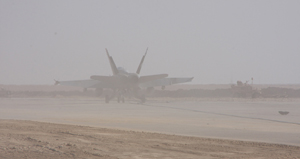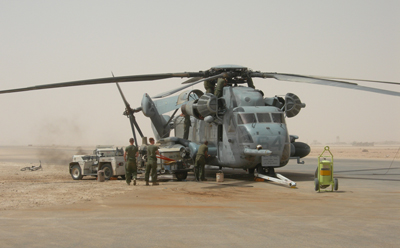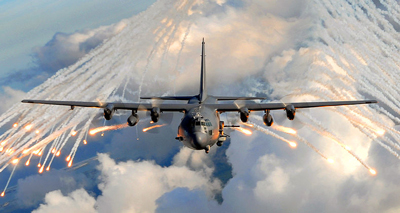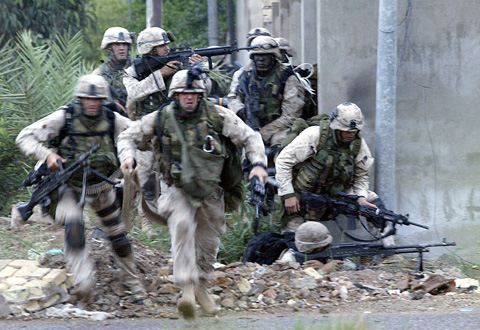CAS: A CORE CONTRIBUTOR TO SUCCESSFUL INTEGRATED OPERATIONS IN FALLUJAH
(Reprinted courtesy of the Marine Corps Gazette. Copyright retained by the Marine Corps Gazette)
By Maj Fred H. Allison, USMCR (Ret)
Maj Allison is a former Marine F–4 radar intercept officer. He earned his doctorate in history from Texas Tech University and is currently a historian at the Marine Corps History Division, Quantico.
***
Paying attention to commonality
RCT–1’s Operation VIGILANT RESOLVE after-action report underscored the great utility of a common map or GRG. Kling and his team enhanced RCT–1’s FALLUJAH I GRG, made it useable for day and night operations, provided different scale maps for different users as appropriate, and made detailed sector maps. Commonality of place names was manifestly important to ensure that supporting fires were expeditious and accurate. It was posted on the 1st MarDiv website for all to access, and Kling and his team of airspace planners made a “round robin theater tour” to ready rooms throughout, including aboard the USS John F. Kennedy (CVA 67), to brief the GRG and keyhole CAS plan. Capt Ellis highlighted the GRG’s importance to pilots: “If you don’t have this in your cockpit . . . if you can’t talk to this, go home; we’ll send you home.”[22]
Finally, the CAS plan for FALLUJAH II relied on Marine Corps-style procedural control. It allowed for routing a lot of aircraft into a tightly confined space, in a compressed time. Procedural control is in variance with Air Force positive control or radar control. Procedural control is less restrictive on pilots.

As a 3d MAW staff officer described it, procedural control is:
. . . like on a highway you can put two cars doing 80 miles an hour and put them three feet apart with a line down the center, and as long as they know not to cross the line [they will be safe], but if I had to do that by radar I’d have to put a huge space between them. So [with] procedural control you can actually saturate the area more with aircraft, so long as everybody goes by the procedures . . . that’s not doctrine to the Air Force . . . they look at it as a loss of control.[23]
Type II CAS—prosecution of a target when neither the pilot nor the FAC sees the target but both have digital imagery or coordinates that can ensure that the right target is hit—was used predominately. This was appropriate for Fallujah because the strike fighters operating above 9,000 feet certainly were not going to get eyeballs onto targets in the brown slur of Fallujah’s architecture, while FACs on the ground often had their views of the targets blocked by buildings, or they had to keep their heads down because of enemy fire. Deep air support, in effect, was being supplied at close range.
Targets were discovered or identified by pilots, FACs, and JTACs. Information was exchanged, as the same imagery was often shared between one and another. Once positive identification was made, clearance to attack was passed to the pilot by a FAC or JTAC. Although no one really had eyes-on, the target could be very close, even across the street. A vertically delivered bomb could collapse the building with little danger of fratricide because the building would contain the blast.[24] Buildings next to other buildings that had been struck by bombs still stood; their windows had not even been blown out. A few pock marks evidenced a blast that had destroyed a building only ten meters away. Insurgent hideouts also were mini arsenals. By collapsing the building, insurgents were killed and arsenals destroyed and therefore not available for leakers to use later.[25]


Relying on the whole gamut of air assets
Airstrikes did not stop at night. Air officers and FACs, leveraging UAS-gained intelligence prepped the battlefield for the next day, taking down buildings known to harbor insurgents or arms caches. The ever popular, and omnipresent, Air Force AC–130U droned overhead, its optics and sensors surveying and reconnoitering the urban battlefield, exchanging information with FACs and air officers on the ground. Its sensors could pick up body heat, and when they did, insurgents were quickly ushered into Allah’s waiting arms. It was music to the Marines’ ears at night, “. . . background music for everyone. He would lull everyone to sleep with the ‘giant potato gun.’ The Marines loved it.”[26]
The accuracy of the air-delivered fires was phenomenal. Minarets attached to mosques, obviously prime insurgent observation points and snipers’ posts, were often targeted. A laser Maverick, guided bomb unit, or laser-guided bomb could “roll the thing open like a can,” and leave the mosque itself virtually undamaged.[27] Strafing at times too was appropriate and could have an awesome impact. One Marine commander noted how Harriers and Hornets were brought down to 3,000 feet and made a strafing pass. “It had an awesome impact,” he asserted.[28]
The keyhole CAS plan allowed virtually the entire arsenal of coalition air assets to be brought to bear—not only strike fighters and attack helicopters of all Services, but also electronic warfare aircraft, Navy and Marine EA–6Bs, which remained adjacent to the city and employed electronic magic to impair the enemy’s communications system. The Navy’s big submarine-chasing P–3s, now equipped with a full suite of electronics, provided enhanced intelligence, surveillance, and reconnaissance and C2 assets. Rotary-wing aircraft operating on Fallujah’s fringes at times used laser energy from fixed-wing fighters above to guide their Hellfire missiles to targets within the city. Attack helicopters also escorted casualty evacuation flights and land convoys around the city. That’s what Marine AH–1W Cobras were doing on 11 November 2004 when two of them were shot down within minutes of each other at two different locations, one west of Fallujah and the other north, pointing out that the rotary-wing CAS birds were in a real down-and-dirty gunfight with the insurgents.
It also serves to remind us that airspace for the high-flying TacAir indeed had a permissive environment in Operation AL FAJR; the enemy fired nothing that threatened their sanctuary. If the enemy had employed weapons that could range them, the CAS plan and its implementation would have been entirely different. But the enemy did not, and the value of TacAir, tied with precision weaponery and targeting, was made obvious, and in the case of FALLUJAH II, it was predominately Marine TacAir. Although Air Force, Army, and Navy aircraft flew numerous strikes, in the final tally, at least 80 percent of the CAS strikes in November in Fallujah were delivered by 3d MAW aircraft, precisely and expeditiously. Approximately 318 precision bombs, 391 rockets and missiles, and 93,000 machinegun or cannon rounds were sent down range by aircraft—in concert with over 6,000 artillery rounds and almost 9,000 mortar rounds fired.[29] There were no fratricides.
This blitzkrieg of supporting fires no doubt caused the deaths of many of the estimated 2,000 insurgents who had chosen to stay and fight. The city was not reduced to rubble. True insurgent strongholds went down, but minor damage was inflicted compared to other cities that have endured an intense urban fight supported by aviation.[30] Civilians, the vast majority of whom had vacated the city thanks to a focused information operations program, returned in time to vote in large numbers in the election held on 30 January 2005.
***
Footnotes:
22. Ellis interview; Kling-author interview.
23. Col Ken Lee, interview by author and David Anderson, 15 June 2007, Headquarters Marine Corps, transcript held by Marine Corps History Division, Quantico.
24. LtCol John M. Butterworth, , interview by LtCol John Way, 4 February 2005, Iraq, transcript held by Marine Corps History Division, Quantico.
25. Kling-Way interview.
26. Maj David P. Smay, and Maj David E. Straub, interview by author, 17 May 2007, Patuxent River, MD, transcript held by Marine Corps History Division, Quantico; Capt William Vaughn interview by by Maj Joe Winslow, 7 January 2005, Iraq, transcript held by Marine Corps History Division, Quantico.
27. Smay and Straub interview.view.
28. Toolan interview.
29. 3d MAW MicroSoft PowerPoint briefing dated 18 January 2006, information held by Marine Corps History Division, Quantico.
30. Jonathan Keiler,“Who Won the Battle of Fallujah,” Proceedings, Naval Institute Press, Annapolis, MD, January 2005, pp. 60–61.
———-
***Posted February 11th, 2010



